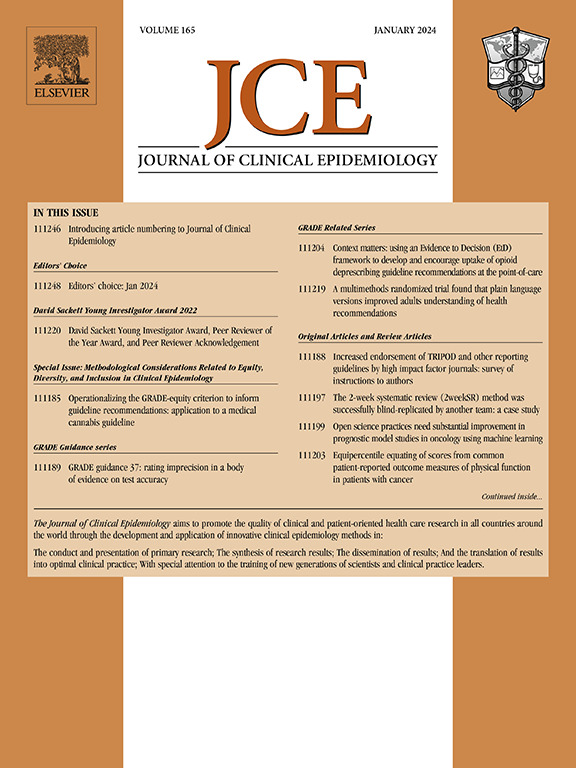Patient- and public-driven health research: a model of coleadership and partnership in research priority setting using a modified James Lind Alliance approach
IF 7.3
2区 医学
Q1 HEALTH CARE SCIENCES & SERVICES
引用次数: 0
Abstract
Objectives
To describe the Strategy for Patient-Oriented Research Evidence Alliance's methodological approach to systematically identify 23 high priority health research topics (three in 2021 and 20 in 2023) from patient partners (including caregivers) and members of the public across Canada and beyond.
Study Design and Setting
In 2021 and 2023, we collaborated with patient and public partners to co-design and co-conduct two priority setting initiatives. These initiatives involved a diverse group of patients, the public, clinicians, researchers, and health system decision-makers to systematically and collectively prioritize research topics based on their perceived importance and anticipated impact. We used a modified James Lind Alliance approach, where all participants were engaged as equal partners. The prioritization process consisted of the following steps: 1) identification and collection of research priorities from patients and the public; 2) summarizing the research priorities gathered; 3) conducting semistructured interviews (1-on-1 or focus groups depending on the number of submissions for each unique topic), conducting literature searches on each topic to identify relevant knowledge synthesis and appraising the quality of relevant evidence using the AMSTAR 2 (A MeaSurement Tool to Assess systematic Reviews) checklist, and preparing lay summaries (1–2 pages) for each unique topic using a predefined template cocreated with patient partners; 4) conducting a priority setting exercise with a multidisciplinary panel consisting of an interim priority setting rating questionnaire to score each topic based on nine questions, followed by a virtual workshop to reach consensus on the final rating and ranking of topics; and 5) facilitating research by funding selected topics and providing capacity-building support to research teams. We conducted a formal process evaluation of engagement, transparency, information management, and considerations of values and context in 2023.
Results
A total of 98 topics were received across two research priority setting initiatives. Approximately, half the submissions were made by individuals who identified as patients (2021: 45% [n = 5] and 2023: 52% [n = 45]), whereas the rest identified as caregivers or members of the public. Topics were spread across 26 health themes, with arthritis and osteoporosis (27% [n = 3]) being the most common theme in 2021 and quality of care (26% [n = 23]) in 2023. Twenty-three priorities from 98 topics submitted by patients and public were selected. A formal process evaluation in 2023 revealed 85% of the respondents who participated in the priority setting panel “strongly agreed” that their experience was valuable and they would participate again in a future initiative. The 23 prioritized projects are currently being co-led with the patient and public partner topic submitters and nominated research teams.
Conclusion
Priority setting exercises successfully engaged a diverse group of interested parties, resulting in the identification of relevant and impactful research topics. The positive feedback from participants suggests that these exercises were well-received and that similar methodologies should be applied and refined in future efforts.
Plain Language Summary
The Strategy for Patient-Oriented Research Evidence Alliance used a patient- and public-driven approach to set research priorities across different topics. They conducted two priority setting initiatives in 2021 and 2023, involving patients, the public, researchers, clinicians, and health system managers. This approach aimed to prioritize research topics based on their perceived importance and anticipated impact. A total of 98 topics were received across two research priority setting initiatives, with nearly half the submissions from patients and the other half from caregivers or members of the public. The topics covered 26 health themes, with arthritis and osteoporosis (2021) and quality of care (2023) being the most common themes. From these topics, the 23 highest priority topics were selected by a multidisciplinary priority setting panel. A formal process evaluation in 2023 revealed that 85% of the respondents who participated in the priority setting panel “strongly agreed” that their experience was valuable, and they would participate again in a future initiative. In conclusion, the priority setting exercises successfully engaged a diverse group of individuals and identified important research topics. The positive feedback suggests that this approach was well received and should be applied in future efforts.
病人和公众驱动的健康研究:使用改进的詹姆斯·林德联盟方法在研究优先设置中的共同领导和伙伴关系模型。
目的:描述SPOR证据联盟系统地从加拿大及其他地区的患者合作伙伴(包括护理人员)和公众中确定23个高优先级健康研究课题(2021年3个,2023年20个)的方法方法。研究设计和设置:在2021年和2023年,我们与患者和公共合作伙伴合作,共同设计和共同实施了两项优先设置计划。这些倡议涉及不同群体的患者、公众、临床医生、研究人员和卫生系统决策者,根据其感知的重要性和预期的影响,系统地和集体地优先考虑研究主题。我们采用了改良的詹姆斯·林德联盟方法,所有参与者都是平等的合作伙伴。优先排序过程包括以下步骤:1)从患者和公众中确定和收集研究重点;2)总结收集到的研究重点;3)进行半结构化访谈(1对1或焦点小组,具体取决于每个独特主题的提交数量),对每个主题进行文献检索,以确定相关知识综合,并使用AMSTAR 2(评估系统评论的测量工具)检查表评估相关证据的质量,并使用与患者合作伙伴共同创建的预定义模板为每个独特主题准备概要(1-2页);4)由一个多学科小组进行优先级设置,其中包括一份临时优先级设置评级问卷,根据9个问题对每个主题进行评分,然后通过虚拟研讨会就主题的最终评级和排名达成共识;5)通过资助选定的课题和为研究团队提供能力建设支持来促进研究。我们在2023年对参与、透明度、信息管理以及价值观和背景的考虑进行了正式的流程评估。结果:共有98个课题在两个研究优先设置计划中收到。大约有一半的提交是由被确定为患者的个人提交的(2021年:45% [n=5];2023年:52% [n=45]),其余则被确定为护理人员或公众成员。主题分布在26个健康主题中,关节炎和骨质疏松症(27% [n=3])是2021年最常见的主题,护理质量(26% [n=23])是2023年最常见的主题。从患者和公众提交的98个主题中选择了23个优先事项。2023年的一项正式流程评估显示,85%参与优先事项确定小组的受访者“强烈同意”他们的经验是有价值的,他们将再次参与未来的倡议。这23个优先项目目前由患者和公共合作伙伴主题提交者以及提名的研究团队共同领导。结论:优先级设置练习成功地吸引了不同群体的利益相关者,从而确定了相关和有影响力的研究主题。与会者的积极反馈表明,这些活动很受欢迎,在今后的努力中应采用和改进类似的方法。
本文章由计算机程序翻译,如有差异,请以英文原文为准。
求助全文
约1分钟内获得全文
求助全文
来源期刊

Journal of Clinical Epidemiology
医学-公共卫生、环境卫生与职业卫生
CiteScore
12.00
自引率
6.90%
发文量
320
审稿时长
44 days
期刊介绍:
The Journal of Clinical Epidemiology strives to enhance the quality of clinical and patient-oriented healthcare research by advancing and applying innovative methods in conducting, presenting, synthesizing, disseminating, and translating research results into optimal clinical practice. Special emphasis is placed on training new generations of scientists and clinical practice leaders.
 求助内容:
求助内容: 应助结果提醒方式:
应助结果提醒方式:


